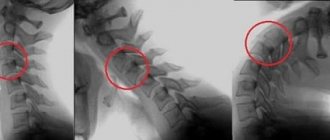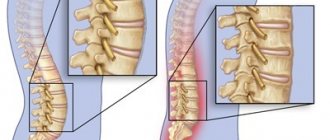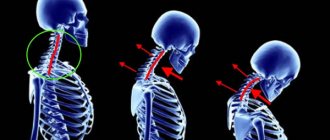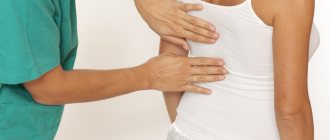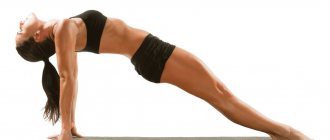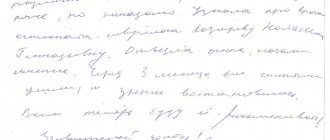Spinal distortion is a condition in which the vertebral bodies are not fixed and can freely move relative to each other. This provokes damage to ligaments, intervertebral discs, articular endplates, etc. In most cases, spinal distortion develops as a secondary pathology against the background of intervertebral disc protrusion (a decrease in its height with an increase in area). Also among the probable risk factors is leading a sedentary lifestyle, in which there is not sufficient physical impact on the muscular frame of the back and collar area. As a result, the diffuse exchange of fluids between tissues is disrupted. This contributes to the degeneration and dystrophy of cartilage, ligament and tendon tissue, since it does not have its own circulatory network.
Distortion of the spinal column is a dangerous disease. The entire spine is made up of individual vertebral bodies. They, together with the lateral processes, form an oval opening. The entire spinal column is one canal in which the spinal cord is located, surrounded by the dural membrane and cerebrospinal fluid. If there is a free dislocation (displacement) of the vertebrae, then the pressure inside the spinal canal increases, and traumatic damage to the membranes of the spinal cord or its structures may occur. As a result, a person may develop paresis or paralysis of certain parts of the body.
In total, the spine consists of 32 vertebrae. Between them are intervertebral discs. These are cartilaginous pads that participate in the uniform distribution of shock-absorbing loads and protect the radicular nerves extending through the foraminal openings in the vertebral bodies from compression. There are five sections: cervical, thoracic, lumbar, sacral and coccyx.
The structure of the vertebra is quite complex:
- massive body consisting of homogeneous bone tissue;
- spinous process, which restrains the backward extension of the spinal column;
- two transverse processes, in the thoracic region they are responsible for connecting with the costal arches, in all other regions they are rudimentary;
- two lower articular processes;
- two superior articular processes.
Some vertebrae have a completely different anatomical structure due to their physiological functions. First of all, these are the atlas (first cervical) and the second cervical vertebra. There is no intervertebral disc between them. The cervical vertebrae in the transverse processes have a narrow canal through which two posterior vertebral arteries pass. They are responsible for the blood supply to brain structures. Therefore, distortion of the cervical vertebrae can lead to acute cerebrovascular accident (stroke) and a number of other dangerous complications.
Definition of disease
Distortion of the cervical spine is a disease that progresses as a result of damage to the ligaments and soft tissues of the area. In this case, as a rule, there is no displacement of the vertebrae and their motor function is not impaired. The disease itself in some cases has complications in the form of tearing of the ligamentous apparatus.
Distortion is associated with mobility and fragility of the cervical spine and can develop in patients of any age. At risk are athletes, office workers who are forced to spend most of their time in a sitting position, as well as patients suffering from osteochondrosis.
The average age of patients is from twenty to forty years. According to statistics, a quarter of the recorded lesions in the cervical area are due to distortion. Distortion of the thoracic spine and lower back is also less common.
How is spinal column stability ensured?
The stability of the spinal column is ensured by a complex ligamentous, muscular and articular apparatus. Between adjacent vertebral bodies there are short yellow ligaments. They record the distance between the vertebrae, taking into account the cartilage pad (intervertebral disc) located between them. If, against the background of long-term osteochondrosis, it loses its elasticity and physiological height, then instability occurs, since the lateral yellow ligament does not contract and allows torsion of the vertebrae.
There are also two long ligaments that run from the first to the last vertebrae. These are the anterior and posterior long ligaments. They are of the white type and have maximum endurance. Their task is to maintain stability of the position of the vertebral bodies in the anterior and posterior plane.
The vertebral arches are connected by ligaments and joints. The intertransverse and interspinous ligaments stabilize the mobile parts of the spine (cervical and lumbar) and allow various bends, twists and turns.
There are three types of intervertebral joints in the structure of the spine:
- facet - connect the vertebral bodies to each other in the area of the articular processes (there are two of them for each vertebral body);
- arcuate – located between the arches of the transverse processes;
- uncovertebral.
When joints or ligaments are damaged, instability in the position of the vertebral bodies occurs. It manifests itself in the form of nagging pain, limited mobility, and stiffness. If you experience such symptoms, try to see a vertebrologist as soon as possible. This doctor carries out differential diagnosis of diseases of the spinal column and develops individual treatment tactics for each patient.
In Moscow, you can make an appointment for a free appointment with a vertebrologist at our manual therapy clinic. Just call the administrator and agree on a time convenient for your visit.
Classification
Distortion is classified according to its causes. So, there are two types of pathology:
- Straight. It occurs as a result of the reaction of the musculoskeletal system to inconvenience, heavy lifting, sudden turns of the head, and improper distribution of load.
- Indirect. It is a consequence of traumatic injuries.
Indirect distortion is considered the most difficult type, since in this case more serious damage and associated injuries are possible.
Prevention measures
To prevent distortion and other diseases of the spine, you must follow simple recommendations. First of all, if we are talking about the cervical spine, all movements of the head must be controlled, so all turns of the head must be smooth and accurate. It is not recommended to make any jerks or sudden movements.
If you want to learn in more detail the structure of the human spine, its sections, functions, and also consider disease prevention, you can read an article about this on our portal.
Prevention
If you are used to constantly dealing with heavy loads, then you need to follow some rules:
- when lifting weights, the back should always be straight and the gaze directed forward;
- you cannot bend down before lifting any heavy object - you must sit down before doing this;
- try to always shift your weight in the center of your body, thereby distributing the load evenly;
- avoid jerks or sudden movements when lifting objects, trying not to look to the side at this time - only in front of you;
- You also need to put the load in place correctly, performing all movements in the reverse order so as not to injure your back.
How to lift objects correctly
The quality of the pillow and the firmness of the mattress also play an important role. Therefore, to prevent distortion, it is necessary to provide optimal conditions for sleep: the pillow should not be too large and hard, and the mattress, on the contrary, should not be too soft. It is advisable to give preference to moderately hard sleeping products - these are ideal conditions.
Orthopedic mattresses
Video - How to strengthen the cervical spine
Causes
The main cause of the development of pathology is traumatic injury to the cervical spine. Among the prerequisites and contributing factors are:
- Regular rest and sleep on an incorrectly selected pillow or mattress (in an uncomfortable position during sleep, a sharp turn of the head is possible, leading to injury);
- Injuries as a result of circumstances, an accident;
- Incorrect load distribution when lifting and carrying heavy objects;
- Sports injuries, mechanical injuries;
- Staying in an uncomfortable position for a long time;
- Weakening of muscles as a result of a sedentary lifestyle.
With muscle weakness caused by constant relaxation and lack of regular physical activity, any sudden movement of the head can provoke a sprain of muscles and ligaments.
Symptoms of pathology
Pain occurs depending on the location of the damaged ligament.
The main symptom is pain when moving. It occurs with the same movements, in the same position. In mild cases, pain may be mild or completely absent; in severe cases, the pain is acute, reminiscent of a sharp needle prick. Radiates to the back of the head, the front surface of the neck, collarbone, arms, chest.
In the acute phase, redness and swelling may occur. Over time, they go away on their own in mild forms or intensify if inflammation begins in the damaged area. When palpating the affected area, the pain noticeably increases. The patient can notice this phenomenon on his own by pressing on the damaged area.
It is possible for distortion to occur completely asymptomatically, when the victim is unaware of the injury that has occurred. In such cases, damaged ligaments can heal on their own, but another option is also possible - the injury will make itself felt in a few years.
First aid in case of pain
If you notice increasing pain in the neck area, you should contact a medical facility. Before this becomes possible, the neck and head must be immobilized. As an immobilizing agent, it is possible to use a Shants collar, a towel rolled into a tourniquet, a bolster or a blanket. It is important that the activity is blocked completely. After this, it is recommended to lay the patient on a flat surface.
The presence of the disease can be determined after a thorough diagnosis. The treatment method will be chosen by a qualified doctor. To relieve pain at home, you can use any painkiller.
First aid
If a person has suffered a serious injury (road accident, accident) and there is a suspicion of a bruise of the cervical spine, then it is important to correctly provide first aid to the victim so as not to provoke aggravation of the situation. In this case, without hardware research methods, it is impossible to determine the nature of the injury - it is a distortion or a spinal fracture, so care is provided as in case of severe trauma.
ADVICE! The patient must be laid on a flat and hard surface, and then a cushion (can be made from folded clothes or a towel) placed under the neck to give a stable position to the patient’s neck.
The back of the head and shoulder blades should be located on the same plane; the head should not hang and bend over the roller - this can cause additional stretching. An ambulance team is called to transport the victim - doctors use methods for additional immobilization and correctly transport the victim.
If necessary, painkillers can be administered on site. A definitive diagnosis in the hospital helps rule out other types of injury and confirm distortion. Further treatment is carried out according to indications.
Diagnostics
In order to identify the presence of spinal distortion, determine the causes of the disease, the scale and depth of the lesion, it is necessary to apply the following medical examination methods:
- Radiography performed in several projections. Helps assess the condition of bone tissue, as well as identify possible damage to the vertebrae and cartilage.
- Computed and magnetic resonance imaging. Allows you to identify damage and the possible presence of inflammatory processes in soft tissues.
In addition, an anamnesis compiled based on a survey of the patient and relatives is required. An external examination of the affected area and palpation is also carried out.
Signs
Symptoms of the disease appear after injury. The degree of rupture of ligament fibers and the severity of some signs of pathology depend on the impact on the neck. In most cases, the patient experiences pain that can be described as acute. In addition, it is difficult for the patient to move his neck, and swelling appears at the site of injury.
In the area of damage, the spinous and transverse processes, which are endowed with the cervical vertebrae, show pain. With swelling along the asymmetry of the neck, this feature is easy to notice visually. This course of the disease leads to compression of the nerve roots by surrounding tissues. The following symptoms may occur:
- numbness and tingling of the skin;
- reduction of the sensitivity threshold;
- weakness of the arm muscles;
- pale and dry skin.
After swelling is removed, these signs of pathology disappear. Local symptoms are disturbing until the torn ligament fibers have completely healed.
Effective methods of therapy
The disease does not pose a serious threat to the life and health of the patient, but it significantly worsens the quality of life. Therefore, when diagnosing cervical spine distortion, it is recommended to begin treatment immediately.
Drug therapy
Medicines can relieve inflammation, relieve pain and other symptoms, and also speed up the tissue healing process. The following groups of medications are used for this:
- Non-steroidal anti-inflammatory drugs (Movalis, Diclofenac, Ibuprofen, Meloxicam);
Movalis
Diclofenac
Ibuprofen
Meloxicam - Muscle relaxants to eliminate muscle spasms (Mydocalm, Sirdalud);
Mydocalm
Sirdalud - Strengthening drugs to improve blood circulation and metabolism (vitamins B and C, calcium supplements).
In some cases, with intense pain, blockades are also used.
Massage and therapeutic exercises
For the first few days, the patient is required to be immobilized, then gradual development of the muscles and vertebrae is necessary. For this purpose, therapeutic exercises, professional acupressure and manual therapy are used.
The exercise therapy complex is selected by a specialist taking into account the patient’s characteristics. In order for the exercises to work correctly and not cause harm, you need to pay attention to the following recommendations when performing:
- The first few days after the start of treatment, exercise therapy should be carried out under the supervision of a physician;
- You should start the course with the simplest exercises, gradually moving on to difficult ones;
- Sudden movements are prohibited, all actions must be performed smoothly;
- If pain occurs, you should stop doing gymnastics and consult a doctor.
Physiotherapeutic methods
Physiotherapy can improve the effect of the above methods on the affected areas, as well as reduce inflammation, swelling, discomfort and pain. To treat distortion use:
- Laser therapy;
- Phono- and electrophoresis using an analgesic;
- Magnetotherapy;
- Acupuncture;
- Balneotherapy;
- Galvanization therapy.
The course of treatment may consist of one or more methods and procedures. It is selected individually for each patient.
Traditional methods of treatment
Many traditional medicine recipes are no less effective than medications. They help relieve pain and swelling, stimulate blood circulation and regeneration processes. Most often, various compresses are used to treat distortion:
- horseradish leaves should be doused with boiling water and applied to the neck, wrapped in a warm scarf;
- make an ointment from a tablespoon of pork fat and the same amount of crushed hop cones;
- fresh cabbage or burdock leaves are tied overnight;
- compresses with camphor alcohol or pepper plaster help;
- rub tincture of lilac flowers and buds into the neck;
- A gruel made from chopped onions and granulated sugar restores ligaments well;
- A hot compress made from infusions of St. John's wort, wild rosemary, hops and wormwood is effective.
Preventive measures
It is quite difficult to prevent the occurrence of the disease due to the instability of the modern rhythm of life. However, there are ways to significantly reduce the likelihood of damage occurring. To do this you will need to use the following recommendations:
- Be careful: avoid traumatic situations, do not ignore safety rules, do not make sudden movements;
- Ensure comfortable rest and sleep, if possible, purchase an orthopedic pillow and mattress;
- Refuse from overwork and carrying heavy objects, and if action is required, when lifting a load you must keep your back straight;
- Properly distribute the load: any load should be located in the center of the body;
- Organize a comfortable workplace;
- Exercise regularly (preferably with a trainer) and avoid muscle flaccidity;
- Timely eliminate diseases of muscles and ligaments, the spine, and also undergo diagnostics.
Spinal distortion: description, causes and symptoms of the disease
sprains (closed injuries) in traumatology are called distortion. Injury to the spine will not disrupt its functionality, but will lead to fragmentary or complete disruption of the integrity of the fibers. When the disease occurs, the vertebrae deviate from each other, which threatens to deteriorate the functioning of the intervertebral discs.
Factors causing damage
Causes of the disease:
- When lifting heavy objects, the spinal column bends.
- An inactive lifestyle will weaken your muscles.
- Participation in an accident.
Signs characteristic of this pathology: the patient complains of numbness, feels a burning sensation in the neck, head and arms.
Diagnostics
To make a correct diagnosis, the doctor examines the patient:
- Interviews, listens to complaints, finds out how the injury was received.
- Examines the site of injury, observes how the spine moves to determine its condition.
- Orders x-rays to make sure there is no fracture, which does not happen with distortion.
- An MRI procedure allows you to examine the ligaments to see if there is a tear in them.
If the cervical spine is injured, bed rest is prescribed for a month.
Therapeutic measures
A wellness course will return activity to the muscular system.
is prescribed .
Manipulations will relax muscles, relieve compression, improve blood flow, reduce pain, i.e. will start the process of tissue restoration, and the healing of ligaments will happen faster. Massaging can be classic or targeted - the type will be determined by the doctor and performed by a specialist. 10-20 procedures are required.
Acupuncture affects biologically active points of the spine. Reflexology triggers the natural regeneration of damaged tissues, because... they are mechanically affected by a needle, so the pressure on the nerve ending is relieved. To perform acupuncture, the acupuncturist is shown X-rays or MRI data, and clinical blood tests are performed.
Therapeutic exercise strengthens muscle tissue. Exercise therapy begins from the 3rd week of illness. Completing simple tasks will prevent relapse. In the mornings and evenings, light exercises are required. The sequence of training will be drawn up by a physiotherapist, taking into account the individual’s physique.
Do the exercises 3-5 times to strengthen the neck muscles. The load is increased gradually:
- slowly tilt their chin forward, slowly throw their head back;
- smoothly move your head in both directions.
When working sedentarily, you need a break. Warming up for a minute will relax your muscles.
The method of electro-, magneto- and thermotherapy is based on the use of electric and magnetic fields and thermal effects on the body. The procedures will strengthen the biological structure of the body (immunity), relax the muscles and normalize the patient’s condition.
In case of severe complications, an orthopedic product is used. A wide collar made of soft fabric fixes the neck muscles in the correct position and prevents them from pulsating. She is protected from movement and is ensured a state of rest.
In case of distortion, he prescribes blockades with analgesics and decongestants. The injections will suppress pain, swelling, and spasms; they are aimed at regenerating damaged ligaments.
Ointments, gels and patches are prohibited from being used without the advice of a therapist, because All of them have side effects and have contraindications.
Preventive measures
Before the doctors arrive, they fix the cervical spine with a bandage to immobilize the patient. It is placed on a hard surface, with a cushion under the back of the head. If the pain is unbearable, specialists are called.
If a person delays treatment, a headache and aching discomfort in the cervical region will appear. To prevent the disease from developing, and also to avoid exacerbation, watch your movements - they should not be fast.
When lifting a load, a person leaves his back straight. You can't bend over - first they squat. A heavy object is lifted smoothly, without jerking, carefully.
Head turns are soft and neat. During physical exercises, squat, but do not bend. Rest on a firm mattress. Lie down on a soft pillow - it should not rise too high above the sleeping area. Remember the safety rules and strictly follow them.
Preventive folk remedies
You can reduce clinical manifestations yourself at home.
Fresh cabbage leaf
will relieve swelling and eliminate inflammation. Stretch the leaf a little and place it on the diseased area, fix the plant.
For making medicinal cream
Pork lard and crushed dried hop cones are mixed in equal proportions. Apply the composition to the affected area. Rub three times daily for a week. This combination of components helps eliminate pain and heal.
Grind the onion until mushy to obtain 100 g of product. Add 2 teaspoons of granulated sugar. The mixture is rubbed once a day. Treatment - two weeks. The product will relieve inflammation and help restore ligaments.
Warm compresses soaked in a healing composition will also help get rid of pain. E
effective recipes:
- Grated raw potatoes are mixed with honey in a 1:1 ratio. Let it sit for a quarter of an hour, then apply the bandage to the sore area.
- Boil fresh horseradish leaves in water for a few minutes, then cool and apply. Wrap the compress in a woolen scarf.
The simplest therapeutic bath is warm, with a water temperature of 39 C. Calm comes from the fact that the blood vessels dilate. After taking it, you need to stay warm and lie down for half an hour.
After a spinal injury, seek medical attention immediately.
The doctor will prescribe a restorative course of therapy. Author: K.M.N., Academician of the Russian Academy of Medical Sciences M.A. Bobyr
